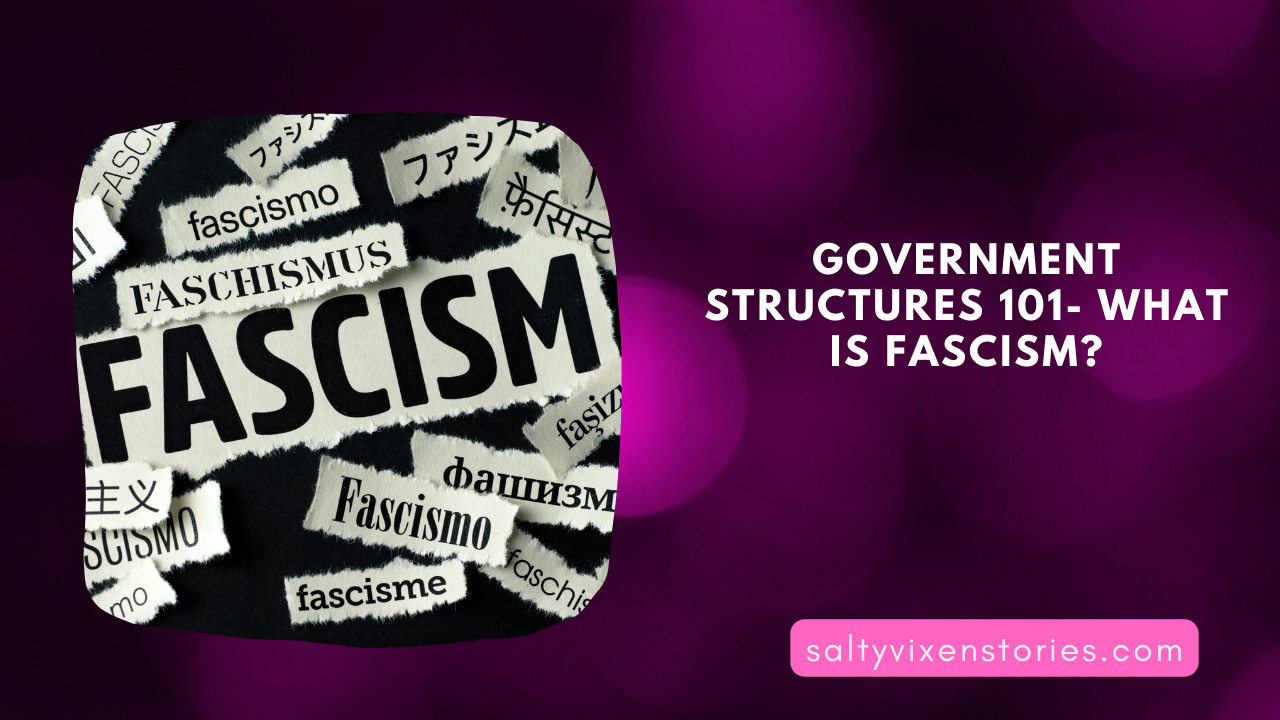This may surprise most educated people. One of the more common government strategies today, especially in developing regions is fascism. Fascism is commonly confused with Nazism. Nazism is a political party platform that embraces a combination of a military dictatorship, socialism and fascism. It is not a government structure. Fascism is a government structure. The most notable characteristic of a fascist country is the separation and persecution or denial of equality to a specific segment of the population based upon superficial qualities or belief systems.
Simply stated, a fascist government always has one class of citizens that is considered superior (good) to another (bad) based upon race, creed or origin. It is possible to be both a republic and a fascist state. The preferred class lives in a republic while the oppressed class lives in a fascist state.
Until the Civil Rights act of 1964, many parts of the US were Republic for whites and could be considered fascist for non-Caucasian residents. Fascism promotes legal segregation in housing, national resource allocation and employment. It provides legal justification for persecuting a specific segment of the population and operates behind a two tiered legal system. These two tiers can be overt as it was within Nazi Germany where Jews, Homosexuals, Catholics, Communists, Clergy and the handicap were held to one set of rules and courts, while the rest of Germany enjoyed different laws.
Or it can be implied and held up by consensual conspiracy, (people know it is wrong but do nothing to stop it or change it. Through lack of action, they give consent), as it was in the deep South for African Americans and others of color. In Fascism, one segment of society is always considered less desirable, sub-human or second class.
(Note: no single government is pure anything. Most have elements of several structures with one dominant structure). Below is the political definition and general characteristics of a fascist country.
GENERAL CHARACTERISTICS OF A FASCIST COUNTRY:
1. Fascism is commonly defined as an open terror-based dictatorship which is:
-
- Reactionary: makes policy based upon current circumstances rather than creating policies to prevent problems; piles lies and misnomers on top of more lies until the truth becomes indistinguishable, revised or forgotten.
- Chauvinistic: Two or more tiered legal systems, varying rights based upon superficial characteristics such as race, creed and origin.
- Imperialist elements of finance capital: Extending a nation's authority by territorial acquisition or by the establishment of economic and political domination of one state over its allies.
Though a dictatorship is the most common association with fascism, a democracy or republic can also be fascist when it strays away from its Tenets of sovereignty. In the 20th Century, many Fascist countries started out as republics. Through the use of fear, societies gave up their rights under the guise of security. Ultimately these republics morphed into Fascist states.
2. Fascism is an extreme measure taken by the middle classes to forestall lower-working class revolution; it thrives on the weakness of the middle classes. It accomplishes this by embracing the middle-class' love of the status-quo, its complacency and its fears of:
- Generating a united struggle within the working class
- Revolution
- Losing its own power and position within society
In a more simplistic term the people currently in control fear that if they allow equal rights and equal consideration to those being oppressed, they will become oppressed and lose everything.
Generally those in power are of a smaller segment of society, but they hold the wealth and control of key systems like manufacturing, law, finance and government position, (e.g. the slave owners in the south prior to the civil war) and the oppressed vastly outnumber them, (the slaves during the same period)
In reality it is the oppressors' fear of retribution by the oppressed that perpetuates fascism; for justification they dehumanize, demonize, strip them of rights, add new laws, restrict movement and attempt to control them by whatever means possible to prevent an uprising.
It is very common in a fascist system to have the oppressed referred to as sub-human, animals, terrorists, savages, barbarians, vermin or any other term designed to create justification for the acts of terror and fascism perpetrated on the oppressed. Via dehumanization society can then accept that the oppressed are incapable of thinking or acting in a peaceful manner or taking care of themselves, and thus society is exonerated from culpability in their own minds. Propaganda, not persuasion, logic or law, is the tool of fascism, though at times very difficult to spot. It specifically rides the fact that negative behavior is innate, (born with) rather than a logical behavior in response to oppression. Propaganda also empowers the oppressors with elitism racially, socially, intellectually and/or spiritually.
THE 7 CONDITIONS (WARNING SIGNS) THAT FOSTER & FUEL FASCISM ARE:
- INSTABILITY of capitalist relationships or markets
- The existence of considerable DECLASSED SOCIAL ELEMENTS
- The STRIPPING OF RIGHTS AND WEALTH focused upon a specific segment of the population, specifically the middle class and intellectuals within urban areas as this the group with the means, intelligence and ability to stop fascism if given the opportunity.
- DISCONTENT among the rural lower middle class (clerks, secretaries, white collar labor). Consistent discontent among the general middle and lower middle classes against the oppressing upper-classes (haves vs have-nots).
- HATE: Pronounced, perpetuated and accepted public disdain of a specific group defined by race, origin, theology or association.
- GREED: The motivator of fascism, which is generally associated with land, space or scarce resources in the possession of those being oppressed.
- ORGANIZED PROPAGANDA:
- a) The creation of social mythology that venerates (creates saints of) one element of society while concurrently vilifying (dehumanizing) another element of the population through misinformation, misdirection and the obscuring of factual matter through removal, destruction or social humiliation, (name-calling, false accusations, belittling and threats).
- b) The squelching of public debate not agreeing with the popular agenda via slander, libel, threats, theft, destruction, historical revisionism and social humiliation. Journalists in particular are terrorized if they attempt to publish stories contrary to the agenda.
- FascismDOVETAILS BUSINESS & GOVERNMENT sectors into a single economic unit, while concurrently increasing in-fighting and distrust between the units fostering advancement towards war.
- a) Fascism PROMOTES CHAUVINIST DEMAGOGY, (appealing to the prejudices and emotions of the populace) by fostering selective persecution and accepted public vilification of the target group. It then promotes this a "patriotic", "supportive" or "the party line" and disagreement with such as "anti-government", "anti-faith" or "anti-nation".
- b) FascismCREATES CONFUSION through "facts". It relies on junk science, revisionism, the elimination of cultural records/treasures and obfuscations to create its case and gain acceptance. Fascism can also combine Marxist critiques of capitalism or faith based critics of the same to re-define middle class perceptions of democracy and to force its issues, confuse logic and create majority consensus between targeted groups. This is also referred to as creating a state of Cognitive Dissonance, the mental state human beings are most easily manipulated.
- Both middle and upper-middle-class dictated democracy and fascism are class dictatorships that useORGANIZED VIOLENCE(verbal or physical) to maintain the class rule of the oppressors over the oppressed.
The difference between the two is demonstrated by the policies towards non-lower-working class classes. Fascism attains power through the substitution of one state's form of class domination with another form, generally a middle class based republic segues into an open terrorist dictatorship, run by a few elite.
THE 14 DEFINING CHARACTERISTICS OF FASCISM
by Dr. Lawrence Britt
Dr. Lawrence Britt has examined the fascist regimes of Hitler (Germany), Mussolini (Italy), Franco (Spain), Suharto (Indonesia) and several Latin American regimes. Britt found 14-defining characteristics common to each:
- POWERFUL AND CONTINUING NATIONALISM -
Fascist regimes tend to make constant use of patriotic mottos, slogans, symbols, songs, and other paraphernalia. Flags are seen everywhere, as are flag symbols on clothing and in public displays. - DISDAIN FOR
THE RECOGNITION OF HUMAN RIGHTS -
Because of fear of enemies and the need for security, the people in fascist regimes are persuaded that human rights can be ignored in certain cases because of "need." The people tend to look the other way or even approve of torture, summary executions, assassinations, long incarcerations of prisoners, etc. - IDENTIFICATION OF ENEMIES/SCAPEGOATS
AS A UNIFYING CAUSE -
The people are rallied into a unifying patriotic frenzy over the need to eliminate a perceived common threat or foe: racial , ethnic or religious minorities; liberals; communists; socialists, terrorists, etc. - SUPREMACY OF THE MILITARY -
Even when there are widespread domestic problems, the military is given a disproportionate amount of government funding, and the domestic agenda is neglected. Soldiers and military service are glamorized. - RAMPANT SEXISM -
The governments of fascist nations tend to be almost exclusively male-dominated. Under fascist regimes, traditional gender roles are made more rigid. Divorce, abortion and homosexuality are suppressed and the state is represented as the ultimate guardian of the family institution. - CONTROLLED MASS MEDIA -
Sometimes to media is directly controlled by the government, but in other cases, the media is indirectly controlled by government regulation, or sympathetic media spokespeople and executives. Censorship, especially in war time, is very common. - OBSESSION WITH NATIONAL SECURITY -
Fear is used as a motivational tool by the government over the masses. - RELIGION AND GOVERNMENT ARE INTERTWINED -
Governments in fascist nations tend to use the most common religion in the nation as a tool to manipulate public opinion. Religious rhetoric and terminology is common from government leaders, even when the major tenets of the religion are diametrically opposedto the government's policies or actions. - CORPORATE POWER IS PROTECTED -
The industrial and business aristocracy of a fascist nation often are the ones who put the government leaders into power, creating a mutually beneficial business/government relationship and power elite. - LABOR POWER IS SUPPRESSED -
Because the organizing power of labor is the only real threat to a fascist government, labor unions are either eliminated entirely, or are severely suppressed. - DISDAIN FOR INTELLECTUALS AND THE ARTS -
Fascist nations tend to promote and tolerate open hostility to higher education, and academia. It is not uncommon for professors and other academics to be censored or even arrested. Free expression in the arts and letters is openly attacked. - OBSESSION WITH CRIME AND PUNISHMENT -
Under fascist regimes, the police are given almost limitless power to enforce laws. The people are often willing to overlook police abuses and even forego civil liberties in the name of patriotism. There is often a national police force with virtually unlimited power in fascist nations. - RAMPANT CRONYISM AND CORRUPTION -
Fascist regimes almost always are governed by groups of friends and associates who appoint each other to government positions and use governmental power and authority to protect their friends from accountability. It is not uncommon in fascist regimes for national resources and even treasures to be appropriated or even outright stolen by government leaders. - FRAUDULENT ELECTIONS -
Sometimes elections in fascist nations are a complete sham. Other times elections are manipulated by smear campaigns against or even assassination of opposition candidates, use of legislation to control voting numbers or political district boundaries, and manipulation of the media. Fascist nations also typically use their judiciaries to manipulate or control elections.
COMMENTARY:
An interesting note to end this article: Dating back to January 2004, the United States fulfills all fourteen points of fascism and all seven warning signs are present. But we're not alone. Israel also fulfills all fourteen points and all seven warning signs as well. Welcome to the new republic, redefined, revised and spun. It is not too late to reverse this in either country, but it will be soon. The first step is realizing it. The second step is getting involved. As the propaganda slogan disguising our current war goes, "Freedom isn't free." But our war for freedom isn't abroad; it's here at home.
Additional Reading....
1) THEY THOUGHT THEY WERE FREE, By Milton Mayer
"They Thought They Were Free: The Germans 1933-1945", University of Chicago Press. Reissued in paperback, April, 1981. As Harpers Magazine noted when the book was published in 1955 (U. of Chicago), Milton Mayer’s extraordinarily far-sighted book on the Germans is more timely today than ever. (Salty Vixen Stories & More has the reprint for you to read)
2) This is not an endorsement of Socialism or Communism, which are fundamentally at odds with the US Constitution. However, reading some of the works on Fascism during the 1920's & 1930's in Europe by members of the Communist and Socialist parties will provide you with additional insights. You may want to start with: FASCISM: WHAT IT IS AND HOW TO FIGHT IT by Leon Trotsky
Whenever U.S. officials wish to demonize someone, they inevitably compare him to Adolf Hitler. The message immediately resonates with people because everyone knows that Hitler was a brutal dictator. In the presidential election held on March 13, 1932, there were four candidates: the incumbent, Field Marshall Paul von Hindenburg, Hitler, and two minor candidates, Ernst Thaelmann and Theodore Duesterberg. The results were:
- Hindenburg 49.6 percent
- Hitler 30.1 percent
- Thaelmann 13.2 percent
- Duesterberg 6.8 percent
Read Jacob Hornberger's Full Article on The Future of Freedom Foundation
Definitions
Proletariat (aka lower-working class (adj)):
1 the lowest class of citizens of ancient Rome who had no property
2: belonging to or characteristic of the proletariat (n) : a member of the working class (not necessarily employed); "workers of the world--unite!"
Bourgeois (aka middle classes (n)): the social class between the lower and upper classes: Middle Class
Imperialism (n): The policy of extending a nation's authority by territorial acquisition or by the establishment of economic and political domination of one state over its allies and over other nations. 2: The system, policies, or practices of such a government.
Demagogy (n): Impassioned appeals to the prejudices and emotions of the populace
Obscurantism, Obfuscation (n):
- The principles or practice of delivering vague truths and hiding key facts.
- A policy of withholding information from the public.
- The act of lying through selective omission
Tyranny (n):
- A form of government in which the ruler is an absolute dictator and is not restricted by a constitution, laws or opposition etc.
- Dominance over a populous through threat of punishment, terrorism, oppression and violence
Autocracy (n):
- Government by a single person having unlimited power; tyranny, dictator.
- A country or state that is governed by a single person with unlimited power.




















